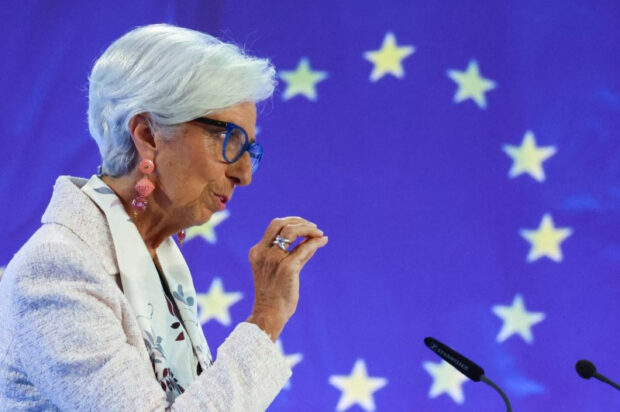Crunch time after string of aggressive central bank interest rate hikes

European Central Bank President Christine Lagarde speaks to the media following the Governing Council’s monetary policy meeting at the ECB headquarters in Frankfurt, Germany, July 27, 2023. REUTERS/Kai Pfaffenbach
LONDON – It is crunch time. Major central banks have confounded economists with a string of interest rate rises that, so far, have moderated inflation without causing global recession.
Now comes the challenge: how to pause monetary tightening without unleashing market exuberance about future rate cuts that would loosen financial conditions and revive price pressures.
The European Central Bank on Thursday raised rates by 25 basis points (bps), while the U.S. Federal Reserve next week is expected to keep borrowing costs steady, while trying hard to rein in speculation about future easing.
So far, nine developed economies have raised rates by a combined 3,915 bps in this cycle. Japan is the holdout dove.
Here’s where central banks stand, ranked by how much they have hiked so far this cycle:
1) United States
Following a string of rate rises, inflationary pressures are moderating. The unemployment rate ticked up to 3.8 percent in August. Consumer prices, excluding volatile food and energy items, rose 4.3 percent, the smallest year-on-year rise for almost two years.
Economists polled by Reuters expect the Federal Reserve to leave its benchmark rate unchanged, at 5.25 percent to 5.5 percent, at its Sept. 19-20 meeting.
2) New Zealand
The Reserve Bank of New Zealand lifted its cash rate to a 14-year high of 5.5 percent in May and has kept it there since. A front-runner in withdrawing pandemic era stimulus, the RBNZ has pushed out when it expects to start cutting borrowing costs to 2025.
3) Britain
Money markets tip the Bank of England to raise rates for the 15th consecutive meeting on Sept. 21 to 5.5 percent and the highest since 2007.
Despite a weakening housing market, the UK economy is still avoiding a widely predicted recession. Inflation in July was more than triple the BoE’s 2 percent target. Almost half of economists polled by Reuters expect the BoE to hike again in the final quarter of 2023 before pausing.
4) Canada
Bank of Canada Governor Tiff Macklem said on Sept. 7 that monetary policy may not be tight enough to return to target.
His hawkish remarks came a day after the Bank of Canada kept its key rate at 5 percent, but said it could hike again should price pressures persist. Inflation has remained above the bank‘s 2 percent target for 27 months.
5) Euro zone
The ECB raised its key rate to 4 percent, the highest level since the euro currency was launched in 1999, but it signaled this could be its final move in a more-than year-long fight against stubbornly high inflation.
It also raised its forecasts for inflation, which it now expects to come down more slowly towards its 2 percent target over the next two years, while cutting its expectations for economic growth.
6) Norway
The Norges Bank has said it will likely nudge benchmark borrowing costs higher this month following a 25 bp rise in August to 4 percent.
Data released after the Norge’s Bank‘s last meeting showed core inflation unexpectedly declined to 6.3 percent in August, however, reducing pressure on monetary policymakers to stay hawkish after their Sept. 21 meeting.
7) Australia
The Reserve Bank of Australia kept rates steady at 4.1 percent for a third consecutive meeting in September, the last under former Governor Philip Lowe.
Lowe’s successor, Michele Bullock, is expected to strike a similar tone on Oct. 3. Markets are wagering that rate hikes are over after the RBA forecast consumer price inflation, at 4.9 percent in July, would return to target in late 2025.
8) Sweden
Traders reckon the Riksbank is likely to raise rates by 25 basis points to 4 percent on Sept. 20, with the almost 7 percent slump in the Swedish crown against the euro this year at the front of policymakers’ minds.
The Swedish government expects GDP to contract 0.8 percent in 2023 while the Riskbank sees house prices falling 15 percent to 20 percent from their February 2022 peak. But inflation, at 4.7 percent in August, remains too high for comfort.
9) Switzerland
Swiss inflation held steady at 1.6 percent in August, firmly within the Swiss National Bank‘s target range.
According to pricing in derivatives markets, traders think there’s a roughly 60% chance the SNB keeps rates on hold at 1.75 percent on Sept. 21.
10) Japan
The Bank of Japan, the world’s most dovish major central bank, meets next week.
Japanese policy makers emphasize that rate rises remain a long way off. Still, the future of the BOJ’s policy of controlling government bond yields remains a focus, particularly as it has contributed to yen weakness. The yen has slumped roughly 10 percent against the dollar this year.
The BOJ shook markets in July by making this yield curve control policy more flexible.